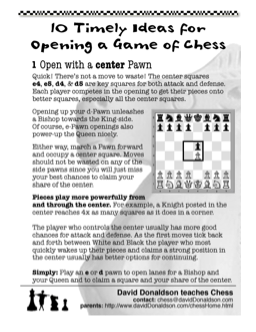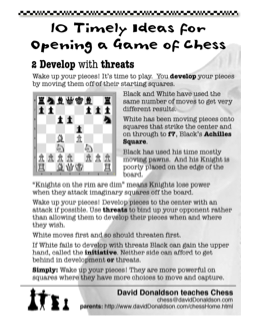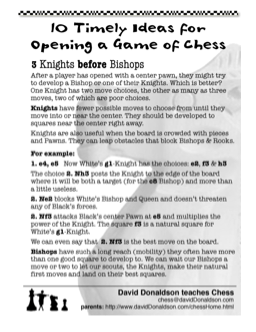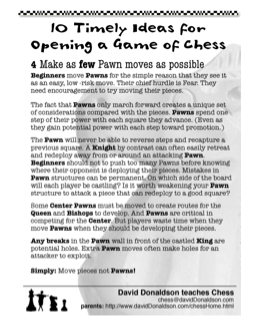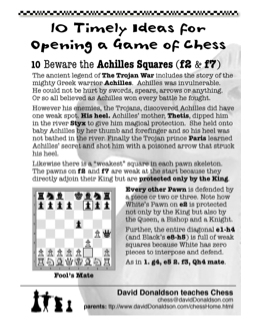10 Timely Ideas

About these Timely Ideas
(Disclosure: Four of these "Timely" Ideas are really "Spacely" Ideas. :-)
After learning the moves of the pieces, the Beginner needs to develop confidence in those first moves away from the starting position.
Beginners minds are inevitably crowded with a gaggle of conflicting ideas. Lots of new information competing with older sometimes wrong information. (Like "You can only promote a Pawn to a Queen if you have lost your original Queen".)
Beginners who demonstrate these ideas over the board are ready to be promoted.
There is an demonstration thirteen move game, Peter vs Alex, from a Weibel Quad that applies to all points but especially 10.6 Don't bring out your Queen too early.
Handout: 10 Timely Ideas for Opening a Game of Chess
The pdf handout of the unit checklist.
All my students get this piece of paper put in their hands.
I don't always print out all the following detail pages for each student.
But the details below can each form the basis of a lesson when paired with the right short game and activity. Parents may wish to print out these details for their child's notebooks.
Point by Point pdfs
May be printed out at home for a student notebook.
1. Try to claim your share of the Center.
2. Open paths to allow development of your Bishops and Queen.
3. Try to leave your side Pawns in place until after castling.
10.2 Develop with threats
4. Wake up your pieces!
5. Threaten your opponent's pieces and King.
6. If White fails to attack Black may gain the Initiative.
7. Knights can mobilize more quickly towards the Center by jumping the Pawn wall.
8. Knights have fewer good squares than Bishops at the start of a game.
9. There is often a "natural" first jump square which a Bishop should not occupy.
10.4 Don't move the same piece twice
10. Each time you move the same piece in the opening you risk giving your opponent a free move. Reach for another piece!
11. Waking another piece gives your opponent another piece to worry about. Keep threatening!
10.5 Make as few Pawn moves as possible
12. While you are moving Pawns your opponent is developing pieces.
13. Any break in the Pawn wall in front of the King creates weak squares and holes for attackers. Pawns can't back up!
10.6 Don't bring out your Queen too early
14. Don't advance your Queen because of the time lost running away from smaller pieces. Wait until you have a better idea of the safe squares for your Queen.
15. Harassing pieces often get a free move to develop.

10.7 Castle as soon as possible, on the King-side if you can
-
16. Castling is a "two-fer": players get to move their King to safety and develop a Rook into or next to an open Center file.
-
17. Castling quickly can help protect the Achilles Square.
-
18. It's often faster to castle King-side because the Queen is not in the way.

10.8 Try to control the Center
19. The player who controls the best squares has more powerful choices for their pieces.
20. Center control can sometimes keep an opponent bottled up.

10.9 Try to keep at least one Pawn in the Center
21. It is more efficient to hold territory with Pawns than with pieces.
22. Pawns can support the advanced position of a larger piece, such as a Knight or Bishop.
10.10 Beware the Achilles Squares
-
23.There is a weak square in each Pawn wall that is protected only by the King.
-
24. Fool's Mate is based on the weakness of the diagonal that runs from the h-file through this square to the King.


